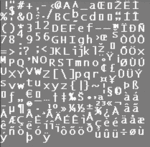FXY File Format: Difference between revisions
m (→Struct: Arma clarified) |
m (→Struct: Typos) |
||
| Line 31: | Line 31: | ||
===Struct=== | ===Struct=== | ||
The fxy is a contiguous series of 12 byte entries. For OFP, the | The fxy is a contiguous series of 12 byte entries. For OFP, the typically contain 224 entries, because the first 32 indexes of an Ascii codepage are unprintable, which leaves 256-32= 224. ArmA fxy's have 1088 entries, as each font supports both Western European, Eastern European and Cyrillic characters. | ||
Each entry can be described in the following struct | Each entry can be described in the following struct | ||
| Line 43: | Line 43: | ||
'''CharCode''' | '''CharCode''' | ||
ASCII (OFP) or Unicode (ArmA) code of the character. While OFP fonts released with the game contain continuous range of characters 0x20-0xff, it is not | ASCII (OFP) or Unicode (ArmA) code of the character. While OFP fonts released with the game contain continuous range of characters 0x20-0xff, it is not necessary for each font to implement it. Any font file can skip any characters not supported by it. | ||
'''PaaFileNumber''' -number of texture file: | '''PaaFileNumber''' -number of texture file: | ||
Revision as of 15:40, 28 December 2007
Introduction
The OFP and ArmA engines use a limited set of bit mapped fonts developed by Bohemia Interactive for the engine. They are bitmaps and each glyph within is treated as a texture.
A character set (such as Ascii) is a series of 'glyphs' (characters) where any one of these characters is always identified by the same index value. For example the letter A is always hex 41 and so on. Regardless of the font set employed, the character set within it, is set-in-concrete. Hex 41 always renders a glyph that 'looks like' the letter A. Be it bold, italic, or fills the entire screen, it is the letter 'A'.
The character set for all BI fonts in OFP is different for each language version. For Western languages it approximates US-Ascii codepage 437. In ArmA Unicode is used for fonts.
A font set is a collection of displayable characters (termed glyphs) that have a common appearance. Eg all glyphs in THIS set are bold, or all the glyphs are italic, all the glyphs are Times Roman (seriffed).
Individual font sets exist for Tahoma, Garamond, and so on.
The glyphs within these sets, are contained in .paa files. Generally, the entire font set = one, paa file.
And, because these are bitmapped fonts, eg fixed dimensions, non-scaleable, there are unique font sets, for, unique sizes.
For example, in Resistance engine, the popular Tahoma font is in three different font sets. 24 point, 36 point, 48 point.
A 'point' approximates 1/72th of an inch. Thus the Tahoma fonts available (for Resistance) are approximately a third, a half, and two thirds of an inch tall when displayed.
Description
An fxy file is the 'character set' index. It is, the codepage.
An fxy file is implicitly associated with one or more paa files within the same folder. The fxy file is the header entry for these files, it describes the position in the paa file and the size to be rendered on screen, for a 'glyph'.
Association of files between fxy and paa is implicit. The CourierNewB64.fxy is implicitly associated with the CourierNewB64-xx.paa file(s). xx indicating one of several CourierNewB64 paa's.
Struct
The fxy is a contiguous series of 12 byte entries. For OFP, the typically contain 224 entries, because the first 32 indexes of an Ascii codepage are unprintable, which leaves 256-32= 224. ArmA fxy's have 1088 entries, as each font supports both Western European, Eastern European and Cyrillic characters.
Each entry can be described in the following struct
struct FxyEntry {
ushort CharCode; // 0x21 = 'A' <<< see note
ushort PaaFileNumber; // 01
ushort X,Y // Top-left Corner of char on the texture in pels
ushort Width,Height; // 10,14 in bytes.
};
CharCode
ASCII (OFP) or Unicode (ArmA) code of the character. While OFP fonts released with the game contain continuous range of characters 0x20-0xff, it is not necessary for each font to implement it. Any font file can skip any characters not supported by it.
PaaFileNumber -number of texture file: This is simply a convenience to allow large fonts to be spread across several paa's.
font name is "CourierNewB64" Fxy file is "CourierNewB64.fxy", First texture file is "CourierNewB64-01.paa", second is "CourierNewB64-02.paa".
Usage
This example using the new font name in a ArmA description.ext.
class RscText
{
type = CT_STATIC;
idc = -1;
style = ST_LEFT;
colorBackground[] = {0, 0, 0, 0};
colorText[] = {1, 1, 1, 1};
font = Bitstream;
sizeEx = 0.04;
};
Paa Content
Resistance
.paa files used for the font must be in 8080 format: (Alpha luminosity)
8bit - Brightness (all with 255 value - "white"); 8bit - Alpha (255 for character, 0 for space);
ArmA
Arma Glyph files (paa) are formatted in DXT5 compressed textures. Using the TAGG labelling, they must additionally specify
Avg Color: any Max Color: always FFFFFFFF AlphaFlag: 1
Available Fonts
Resistance and CWC
AudreysHand 48pt Italic AudreysHand 48pt Bold CourierNew Bold 64pt Garamond 64 Steelfish bold 64 and 128 pt SteelfishCE bold 64 Tahoma 24/36/48 bold
Elite
Arial Bold 7,8,10,11,12 pt Arial Italic 9,13,18,48 CourierNew 9pt Hel67-CM 10,11 pt HelvCondLight 8,9,10 pt Helvetica-Narrow 11pt Helvetica-Narrow Bold 8pt Helvetica37-CondensedThin bold 10pt Helvetica57-Condensed 10,13,16pt Helvetica57-Condensed 9 ,13,14 pt Bold Helvetica67-Condensed 10,11,9pt Medium HelveticaNarrow 10,11pt HelveticaNarrow bold 10,13,18,22 HelveticaNeue 10,11,12,13,14,22 HelveticaNeue Bold 22 B22-01.paa LucidaConsole Bold 11,8 MSS Bold 9 System 10pt System 10pt Bold Tahoma 10,11,12,14,16,20,21pt Tahoma 5,6,7,9,10,11,12,13,14,16,20,21 pt bold Tahoma 12pt Bold Italic
ArmA
Arial Bold 7->24 pt BitStreamVersans bold 7->20, 22, 28 pt Zepellin32 12->20,22,28 pt Zepellin33 12->20,22,28 pt Zepellin33 12->20,22,28 pt italic
